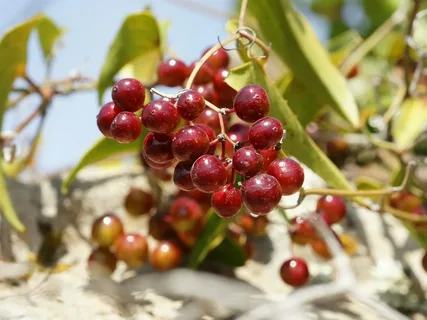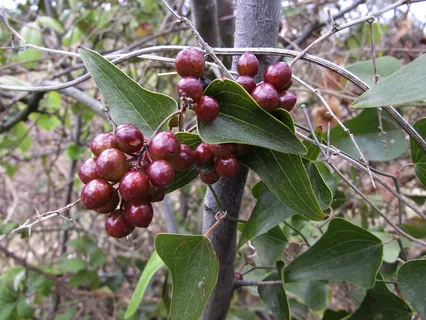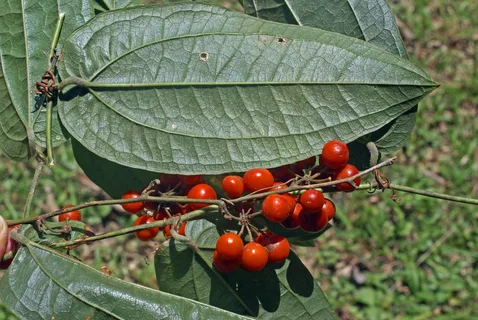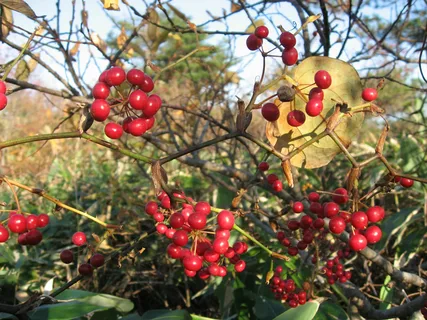Discover the Wonders of Smilax Vine: A Guide to This Amazing Plant
Table of Contents
Introduction
Smilax vine is a fast-growing, climbing plant that can make a beautiful addition to any garden. Known for its glossy green leaves and climbing nature, it’s often used to cover fences, trellises, and arbors. This vine is not just pretty, though—it has many benefits, including providing shelter for wildlife and helping other plants grow taller. Whether you want to add more greenery to your space or are looking for a versatile plant to cover structures, smilax vine is a great choice.
There are several varieties of smilax vine, each offering something unique. Some grow quickly, while others take a bit longer to spread. Some varieties are great for ornamental purposes, while others have been used for centuries in traditional medicine. Choosing the right type of smilax vine for your garden depends on what you need it for, and how much time and care you can dedicate to it.
In this blog, we’ll take a closer look at smilax vine, including how to grow it, the best places for it to thrive, and the different varieties to consider. Whether you’re a beginner or an experienced gardener, smilax vine can bring beauty and function to your outdoor space. Let’s explore how you can incorporate this amazing vine into your garden and home!

What Is Smilax Vine? A Simple Introduction
Smilax vine is a climbing plant that grows quickly and is known for its strong, twisting stems. It is often found in many places around the world, especially in tropical and subtropical regions. Smilax is a hardy plant, which means it can grow in different climates and environments. The vine has glossy, dark green leaves that look attractive and add a lush touch to any garden. It also produces small berries that attract birds and wildlife, making it a favorite among nature lovers.
This vine is not just beautiful, but it is also useful. Smilax vine can grow up to 30 feet tall in some cases, making it perfect for covering walls, fences, or trellises. Because of its climbing ability, the vine wraps around trees and structures to create a green canopy. People often use it to add privacy to their gardens, as it grows quickly and thickly. Smilax can also be used as a natural way to cover unsightly areas or to decorate a space with greenery.
One of the unique things about smilax vine is that it has thorns along its stems. These thorns help the vine grip onto structures and support its growth. While this feature makes the plant strong and able to climb tall, it can also make it difficult to handle. It’s important to be careful when working with smilax vine to avoid getting pricked by its sharp thorns. Despite this, it remains a popular plant due to its beauty and usefulness in the garden.
Another interesting fact about smilax vine is that it has been used in traditional medicine for many years. Some people believe that the vine has healing properties, especially for joint pain and inflammation. The roots of the vine are often used in herbal remedies, which adds to its appeal. However, it’s important to be cautious when using smilax in any form and to consult with an expert before consuming it for medicinal purposes.
In conclusion, smilax vine is more than just a decorative plant. Its ability to climb, cover areas, and provide shelter for wildlife makes it a valuable addition to any garden. Whether you’re using it for its beauty or its medicinal uses, smilax vine is a fascinating plant to learn about. It’s easy to see why it’s becoming a favorite among gardeners and nature enthusiasts alike.
How to Grow Smilax Vine in Your Garden
Growing smilax vine in your garden is an exciting way to add greenery and charm to your outdoor space. The first step in growing this plant is selecting the right location. Smilax vine thrives in areas with plenty of sunlight, although it can also tolerate partial shade. Make sure the area you choose has well-drained soil, as smilax doesn’t like sitting in wet conditions. A sunny spot with good drainage will help your smilax vine grow strong and healthy, producing lush green leaves and beautiful coverage.
Before planting, prepare the soil by loosening it with a shovel or garden fork. You can mix in compost or organic matter to improve the soil’s texture and fertility. This helps the vine develop strong roots. When planting the smilax vine, dig a hole that’s slightly larger than the plant’s root ball. Gently place the plant into the hole, then cover the roots with soil and press it down firmly. After planting, water the vine thoroughly to help it settle into its new home.
One of the best things about growing smilax vine is how quickly it climbs. To encourage this growth, provide the vine with a structure to climb on, such as a trellis, fence, or wall. Smilax will naturally wrap its stems around any nearby support. It’s important to make sure the support is strong enough to handle the vine’s weight as it grows taller. If you don’t have a trellis, you can train the vine by gently guiding it along a fence or string to encourage upward growth.
Once planted, smilax vine needs regular care. Water it consistently, especially during dry periods, but avoid overwatering, as this can lead to root rot. It’s a good idea to mulch around the base of the vine to keep the soil moist and cool. Also, regularly check for any pests or diseases, though smilax is generally resistant to many common garden problems. Pruning the vine can also help keep it healthy and encourage more growth. Simply trim back any dead or unhealthy stems to keep the plant looking tidy.
In conclusion, growing smilax vine in your garden is relatively simple if you follow a few basic steps. With the right sunlight, support, and care, your smilax vine will thrive, adding a beautiful and lively touch to your garden. Just be patient, as this fast-growing plant will soon provide a lovely natural cover that can bring beauty and shade to your outdoor space.

The Best Places for Smilax Vine to Thrive
Smilax vine is a versatile plant that can grow well in many different environments, but there are certain places where it thrives the most. The best location for smilax vine to flourish is one that offers plenty of sunlight. Ideally, the vine needs about six hours of direct sunlight each day. A sunny garden spot will encourage healthy growth and vibrant green leaves. If your garden has an area that gets lots of sun, like near a south-facing wall, that’s a perfect place for the smilax vine to grow strong and fast.
While smilax vine loves sunlight, it can also tolerate some shade. In areas where there is partial shade, such as spots under tall trees or near buildings that block the sun during part of the day, smilax will still do well. However, in shady areas, the vine may grow more slowly and might not be as full and thick as it would be in a sunnier spot. If you’re looking for a plant that can handle some shade but still offer some greenery, smilax vine is a great choice for those spots in your garden.
Another important factor in choosing the right place for smilax vine is the quality of the soil. Smilax prefers soil that is well-drained but still rich in nutrients. It does not like soggy soil, as standing water can cause its roots to rot. For the best results, plant your smilax vine in a spot where the soil drains well. This could be a raised bed or an area with sandy or loamy soil that doesn’t hold onto too much moisture. You can improve the soil by adding compost to ensure it has enough nutrients for the vine to grow strong.
Smilax vine is also a great plant for covering fences, trellises, or walls. If you have a structure in your garden that needs some natural coverage, like an old fence or a garden wall, smilax is the perfect plant to help hide it. It climbs quickly and can cover large areas, making it ideal for adding greenery and privacy to your garden. If you want to create a green screen around your yard, a smilax vine growing along a fence or trellis will do the trick.
In conclusion, smilax vine thrives best in sunny areas with well-drained soil. It can tolerate some shade, but the more sunlight it gets, the better it will grow. Whether you’re using it to cover a fence, wall, or trellis, smilax vine is a flexible plant that can adapt to different garden environments. With the right care and location, it will grow into a beautiful and hardy addition to your garden.
Unique Features of Smilax Vine You Should Know
Smilax vine is an interesting plant with several unique features that set it apart from other climbing vines. One of the most striking characteristics of smilax vine is its ability to grow quickly and vigorously. This fast growth makes it an excellent choice for covering fences, walls, or trellises in no time. Whether you’re looking to add privacy to your garden or just want a lush, green backdrop, smilax can provide the coverage you need. Its climbing nature allows it to easily wrap around structures, creating a natural, beautiful curtain of leaves.
Another distinctive feature of smilax vine is its glossy, dark green leaves. The leaves are thick and shiny, giving the plant a lush and vibrant appearance. These leaves not only add a rich color to your garden, but they also help the vine thrive by providing shade and reducing moisture loss. Smilax vine’s leaves are also quite sturdy, making it a reliable plant that can endure different weather conditions. Whether it’s a hot, sunny day or a chilly, rainy afternoon, the leaves will stay in great condition, adding beauty to your space year-round.
One of the more unique aspects of smilax vine is the presence of thorns along its stems. While this might seem like a disadvantage at first, these thorns actually help the vine climb and stay attached to structures. As the vine grows, the thorns grip onto surfaces, allowing it to rise higher and cover more area. However, these thorns can make handling the plant a bit tricky, so it’s important to wear gloves and take care when pruning or training the vine. Despite the thorns, many gardeners appreciate how the plant can grow so quickly and cover large spaces.
Smilax vine also has small, berry-like fruits that are often overlooked but are equally fascinating. These berries are typically dark in color and appear after the plant has matured. While the berries are not particularly large or showy, they serve an important purpose in nature. The berries attract birds and other wildlife, making smilax a great plant for supporting local ecosystems. If you have a garden with birds or want to attract more wildlife, planting smilax vine can help bring a variety of creatures to your space.
In conclusion, smilax vine stands out due to its fast growth, glossy leaves, thorny stems, and attractive berries. Whether you want to use it to cover a fence, add beauty to a garden, or support wildlife, smilax is a unique and versatile plant. Its distinctive features make it an appealing option for gardeners looking for something different and useful.

Smilax Vine in Traditional Medicine: Uses and Benefits
Smilax vine has a long history of use in traditional medicine, especially in various cultures around the world. For centuries, different parts of the smilax plant, such as its roots and stems, have been used to treat a variety of health conditions. One of the most common uses of smilax vine in traditional medicine is its ability to support joint health. It is believed that the vine has anti-inflammatory properties, which may help reduce pain and swelling in the joints. Many herbal remedies contain smilax root, which is thought to improve mobility and ease discomfort in people suffering from conditions like arthritis.
Another benefit of smilax vine in traditional medicine is its use as a natural detoxifier. Smilax is often used in detoxification programs, as it is believed to help cleanse the body by removing harmful toxins. The vine’s roots are thought to support liver and kidney function, which are both key organs in the body’s detox process. Consuming smilax in the form of teas, tinctures, or capsules is believed to help boost the body’s natural ability to flush out waste products, making it a popular choice for those looking to improve their overall health.
Smilax vine is also known for its potential to boost the immune system. In some cultures, it has been used to strengthen the body’s defense mechanisms and fight off infections. The plant contains compounds that are thought to have antimicrobial properties, which can help protect the body from harmful bacteria and viruses. Some herbalists recommend smilax as a remedy for colds, flu, and other common illnesses due to its immune-boosting effects.
Additionally, smilax vine is believed to have benefits for the skin. In traditional medicine, it is sometimes used to treat skin conditions such as eczema, acne, and psoriasis. The vine’s anti-inflammatory and antioxidant properties are thought to reduce redness, irritation, and swelling. Applying smilax in topical form, such as in herbal creams or lotions, may help soothe and heal the skin, promoting a healthier complexion.
In conclusion, smilax vine has a rich history in traditional medicine, offering a variety of potential health benefits. From supporting joint health to detoxifying the body and boosting the immune system, this vine has been used for many purposes. While more scientific research is needed to fully understand its effects, smilax remains a valuable plant in many natural healing practices. However, it’s always important to consult with a healthcare provider before using smilax for medicinal purposes.
How to Care for Smilax Vine: Tips for Healthy Growth
Caring for smilax vine is relatively easy, as long as you provide the right environment and follow a few essential tips. One of the most important things to consider is the amount of sunlight the vine gets. Smilax thrives in full sunlight, but it can also tolerate partial shade. Ideally, place it in a spot that receives at least 6 hours of direct sunlight each day. The more sunlight it gets, the better the vine will grow. If you have a shaded area, smilax will still grow, but at a slower pace, and it may not be as lush and vibrant.
Watering is another crucial part of smilax vine care. This plant prefers well-drained soil, so it’s important to water it regularly without over-saturating the ground. Keep the soil moist, especially during dry periods, but avoid letting the vine sit in water. If you notice the soil staying wet for too long, it might cause root rot, so be sure the soil drains well. Mulching around the base of the vine can help retain moisture while preventing weeds from growing around it.
Pruning your smilax vine is also an important step in maintaining its health. As smilax grows, it can become quite tangled and unruly. Regular pruning helps the plant maintain its shape and encourages new growth. Trim back any dead or damaged stems, and remove any parts that look overcrowded. Cutting back the vine during its dormant period (late fall or early winter) will also help the plant focus its energy on fresh growth come springtime. Remember to wear gloves when handling smilax, as it has thorns that can be sharp.
In addition to sunlight, water, and pruning, feeding your smilax vine with a balanced fertilizer once a year can promote healthy growth. A slow-release fertilizer that’s high in nitrogen is a good option, as it will encourage lush, green foliage. Avoid over-fertilizing, as this can lead to excessive leaf growth at the expense of flowers or berries. Follow the instructions on the fertilizer package, and be mindful not to apply too much.
In conclusion, caring for smilax vine is simple with the right attention to its needs. Ensure it receives enough sunlight, water it appropriately, prune it regularly, and feed it with fertilizer when needed. By following these care tips, you’ll enjoy a healthy and thriving smilax vine that will provide beautiful coverage and lush greenery in your garden. With a little care, smilax vine will grow strong and provide lasting beauty for years to come.

Is Smilax Vine Poisonous? What You Need to Know
Smilax vine is not considered highly poisonous, but it is important to be cautious when handling it, especially around pets and small children. While the vine itself doesn’t contain harmful toxins that are dangerous to humans, some parts of the plant, particularly the roots and berries, can cause mild irritation or discomfort if ingested. It’s always best to avoid eating any part of the vine unless it has been prepared and used properly under the guidance of a healthcare professional or herbalist.
The most notable concern with smilax vine is the thorns along its stems. These thorns can cause physical injury if you come into contact with them, making handling the vine more difficult. If you are working with smilax in your garden, be sure to wear gloves to protect your skin from being scratched by the sharp thorns. While these thorns are not poisonous, they can be painful, especially if they break off and become embedded in your skin.
For pets, particularly cats and dogs, it’s important to keep them away from smilax vine, as they may be tempted to chew on the plant. While smilax is not known to be toxic to animals, ingesting any part of the plant can cause mild gastrointestinal upset, such as stomach pain or vomiting. If you suspect your pet has eaten part of the smilax vine, it’s always a good idea to contact a veterinarian to ensure there are no adverse effects.
Despite the minor risks, smilax vine is often used in traditional medicine in small, controlled doses for humans, particularly in the form of herbal teas or extracts. When used properly, it has been believed to offer health benefits, such as aiding joint health and detoxifying the body. However, like any plant used in herbal medicine, it’s essential to follow the correct preparation methods and consult a healthcare provider before using it as a remedy.
In conclusion, while smilax vine is not considered highly poisonous, it is important to exercise caution when handling the plant. Its thorns can cause injury, and eating parts of the plant can lead to mild irritation or digestive discomfort. If you have pets or young children, keep them away from the plant, and always be careful when using smilax in traditional medicine. By following these safety guidelines, you can enjoy the benefits of smilax vine without worry.
Decorating with Smilax Vine: Creative Ideas for Your Home
Smilax vine can be a wonderful addition to your home decor, offering a natural and lush look that brings a touch of greenery to any space. One of the most popular ways to use smilax vine in home decorating is by incorporating it into indoor planters or hanging baskets. You can allow the vine to cascade over the edges, creating a beautiful and soft draping effect. This works especially well in living rooms, kitchens, or bathrooms, where the vine can thrive in bright, indirect light. Smilax’s vibrant green leaves make it a great way to add color and life to indoor spaces.
Another creative way to use smilax vine is to decorate your walls or ceilings. You can create a charming wall trellis by training the vine to climb up a lattice or other vertical surface. This will not only add a decorative touch but also help cover up bare walls, creating a more inviting atmosphere. You can also weave the vine through curtain rods or drape it along the edges of a ceiling for a whimsical, nature-inspired look. The vine’s ability to climb and wrap around structures makes it ideal for adding a bit of vertical beauty to any room.
For a more rustic or boho vibe, you can incorporate smilax vine into wreaths and garlands. These make for stunning home accents, especially during the holiday season or for special events like weddings. A smilax vine wreath can be adorned with small decorative items such as berries, dried flowers, or ribbons, adding a personal touch to your decor. Hanging a smilax garland across your mantelpiece or along a staircase railing brings a fresh, organic look to your home, perfect for creating a cozy, nature-filled environment.
Smilax vine can also be used to dress up your outdoor spaces. If you have a patio or balcony, you can hang pots of smilax vine to add some greenery to your seating area. You can even train the vine to climb over outdoor trellises, fences, or pergolas, providing beautiful, natural coverage and adding a bit of shade on sunny days. The vine’s growth can create a relaxed, inviting outdoor oasis where you can unwind and enjoy the beauty of nature right at your doorstep.
In conclusion, smilax vine offers a variety of creative ways to enhance your home’s decor. Whether you choose to use it indoors in planters or as a wall feature, or outdoors on trellises and fences, smilax vine brings a touch of natural elegance to any space. Its ability to grow quickly and easily allows for versatile design ideas that can transform your home into a lush, green haven. With a little creativity, smilax vine can become a key element in your decorating style.

The Role of Smilax Vine in Ecosystems
Smilax vine plays an important role in many ecosystems by providing valuable habitat and food sources for a variety of wildlife. As a climbing plant, it creates dense coverage over trees, shrubs, and fences, offering shelter for birds, insects, and small mammals. This dense growth provides protection from predators, allowing animals to hide and build nests in its thick foliage. Birds, in particular, may use the vine to create nests or roosts, benefiting from the privacy and safety it provides.
In addition to providing shelter, smilax vine is also a food source for some animals. The vine produces small berries that are eaten by various bird species. These berries are especially important during the winter months when other food sources are scarce. Birds and small mammals like squirrels may rely on smilax berries as part of their diet. The vine’s foliage may also be eaten by herbivorous insects and grazing animals, contributing to the food web within its ecosystem.
Smilax vine also plays a role in soil health and erosion control. As a climbing plant, it helps stabilize the soil by growing along fences, trellises, and tree trunks. Its roots can help bind the soil together, preventing erosion and reducing the risk of soil degradation, especially in areas prone to heavy rainfall or wind. In this way, smilax contributes to the overall health and stability of the ecosystem, supporting the plants and animals that depend on the soil for survival.
The vine’s presence can also influence plant diversity in its environment. By climbing over other plants and trees, smilax vine competes for sunlight, water, and nutrients, which can sometimes limit the growth of other plants. While this can be beneficial in some ecosystems by preventing overcrowding of certain species, it can also lead to the dominance of smilax in some areas, impacting the overall biodiversity. However, in many cases, its ability to grow quickly and cover large areas helps balance plant communities and create diverse ecosystems.
In conclusion, smilax vine plays an important role in ecosystems by providing shelter, food, and soil stabilization. Its ability to support wildlife and contribute to ecological balance makes it a valuable part of many natural environments. While it can have both positive and negative effects on plant diversity, the vine’s contributions to the overall health and stability of ecosystems are undeniable.
How Smilax Vine Helps Other Plants Grow Taller
Smilax vine can be surprisingly beneficial to other plants, helping them grow taller by providing support and structure. As a climbing plant, smilax has long, strong tendrils that can latch onto nearby trees, trellises, or other plants. This natural ability to climb allows smilax to offer a helping hand to weaker or smaller plants that may not have the strength to grow upright on their own. By wrapping around and supporting these plants, smilax gives them the stability they need to reach for the sky.
The way smilax vine supports other plants is particularly beneficial in areas where vertical space is limited. When plants grow taller, they have more access to sunlight, which is essential for photosynthesis. Smilax allows these plants to grow higher than they might on their own, which helps them receive more light. This is especially important in shaded areas or dense gardens where taller plants might otherwise struggle to thrive. By providing this extra support, smilax enables other plants to flourish in a way that they might not be able to do by themselves.
Additionally, smilax vine’s rapid growth can help prevent overcrowding among plants. As smilax climbs and spreads out, it often creates a natural barrier that keeps other plants from growing too close together. This spacing allows each plant more room to grow tall without competition for resources like sunlight, water, and nutrients. In this way, smilax vine not only supports vertical growth but also helps create a healthier environment for all the plants in the area, ensuring they each have the space they need to thrive.
Smilax vine also helps plants grow taller by improving air circulation around them. When plants are close together or grow too densely, air circulation can be limited, leading to higher humidity levels and increased risk of fungal diseases. Smilax, with its airy and vine-like structure, allows for better airflow around the plants it supports. This reduction in humidity and the increase in ventilation helps plants remain healthy, thus supporting their overall growth and allowing them to continue reaching for greater heights.
In conclusion, smilax vine helps other plants grow taller by providing essential support, access to more sunlight, and better air circulation. Its climbing nature allows it to lift weaker plants off the ground, giving them the stability they need to thrive. Additionally, smilax contributes to creating a healthier, more spacious environment where plants have room to grow. By offering these benefits, smilax plays an important role in helping other plants reach their full potential.

Common Problems with Smilax Vine and How to Fix Them
Smilax vine is a hardy plant, but like all plants, it can face some challenges in its growth. One of the most common problems is excessive spreading. Since smilax is a vigorous climber, it can quickly become invasive, overtaking other plants or structures in your garden. To manage this, regular pruning is necessary. By trimming back the vine, you can control its growth and prevent it from overwhelming other plants. It’s best to cut back smilax at least once a year, preferably in the late winter or early spring, before new growth begins.
Another issue gardeners may encounter is poor growth or yellowing of the leaves. This could be a sign of nutrient deficiencies, particularly a lack of nitrogen, iron, or other essential minerals. To fix this, you can fertilize the plant with a balanced, organic fertilizer. A slow-release fertilizer is a good choice, as it will provide smilax with the nutrients it needs over a longer period. Additionally, make sure the vine is getting enough water, as inadequate moisture can also cause stress and leaf yellowing.
Smilax vine can also be susceptible to pests, such as aphids, spider mites, and scale insects. These pests can damage the leaves and stems of the vine, causing them to weaken and potentially die. To deal with these pests, you can use insecticidal soap or neem oil. These organic treatments are safe for the plant and effective in controlling common garden pests. For more severe infestations, it may be necessary to prune affected areas and remove the pests manually.
Another issue to watch out for is fungal diseases, particularly if smilax is grown in a humid environment or overcrowded area. Fungal infections, like powdery mildew or rust, can cause white or orange spots on the leaves and hinder the plant’s growth. To prevent fungal problems, ensure that smilax has good air circulation around it and is not overly watered. If you notice signs of fungal disease, remove the affected leaves and apply a fungicide specifically formulated for vine plants. Regular maintenance and attention to air flow can help reduce the likelihood of these issues.
In conclusion, while smilax vine is a low-maintenance plant, it can still face challenges like spreading too quickly, poor growth, pest infestations, and fungal diseases. By regularly pruning, fertilizing, monitoring for pests, and ensuring proper air circulation, you can keep your smilax vine healthy and thriving. These simple fixes will help you enjoy the beauty of this versatile plant without the headaches of common gardening problems.
Smilax Vine Varieties: Which One Is Right for You?
When it comes to choosing a smilax vine for your garden, there are several varieties to consider, each with its unique characteristics and growing requirements. The most common variety is the American smilax (Smilax rotundifolia), which is native to North America. Known for its round, glossy leaves, this variety is great for adding lush greenery to your garden. It’s a hardy vine that can tolerate various soil types and is relatively easy to maintain. American smilax is ideal if you’re looking for a low-maintenance vine that provides great coverage and can thrive in most climates.
Another popular variety is Florida greenbriar (Smilax bona-nox), which is found in the southeastern United States. This variety has longer, narrower leaves compared to the American smilax and is known for its ability to climb and spread rapidly. Florida greenbriar is perfect for gardeners who want a fast-growing vine to cover fences, trellises, or pergolas quickly. However, keep in mind that its aggressive growth may require regular pruning to keep it under control. If you’re looking for a vine that provides fast coverage, Florida greenbriar could be a great choice for your garden.
If you’re interested in a smilax vine that offers both beauty and medicinal properties, consider Smilax officinalis. This variety is often used in traditional medicine and is known for its slender, dark green leaves and small white flowers. Smilax officinalis tends to grow well in areas with plenty of sunlight and well-drained soil. It’s ideal for gardeners looking for a smilax vine that offers both decorative appeal and potential health benefits. However, it does require a little more care and attention compared to other varieties, so it’s best suited for gardeners who are experienced or willing to put in extra effort.
For those seeking a decorative vine with a striking appearance, the Japanese smilax (Smilax china) might be the right choice. This variety features dark green, leathery leaves that contrast beautifully with its white flowers. Japanese smilax is known for its elegant look and can make an attractive addition to your garden, especially when used to cover structures like arbors or pergolas. While it’s not as hardy as the American or Florida varieties, it thrives in warmer climates and can be a great option for gardeners looking to add a touch of exotic charm to their outdoor space.
In conclusion, the right smilax vine for your garden depends on your specific needs and climate conditions. Whether you choose the hardy American smilax, the fast-growing Florida greenbriar, the medicinal Smilax officinalis, or the elegant Japanese smilax, each variety offers unique benefits. By considering factors such as growth speed, appearance, and care requirements, you can choose the smilax vine that best suits your garden and your gardening style.

Conclusion
In conclusion, smilax vine is a wonderful plant to have in your garden. With so many varieties to choose from, you can pick the one that fits your needs best. Whether you want a fast-growing vine, a beautiful decoration, or a plant with traditional medicinal uses, there is a smilax variety for you. Each variety has its own special features, making it easy to find the perfect one for your garden.
Remember, smilax vine is easy to care for as long as you give it the right environment. By providing support, water, and enough sunlight, you can enjoy its beauty and benefits all year round. Whether you are a beginner or an experienced gardener, smilax vine can be a great addition to your garden, helping other plants grow taller and giving your space a fresh, natural look. Happy gardening!














Post Comment